Date : November 12 - 13, 2007
November 12-13, 2007 【Niigata City Press Tour】
post date : 2013.08.23
Niigata, the first ordinance-designated city on the Japan Sea coast,
hosts 2008 G8 Summit Labor Ministers’ Meeting
--Blessed with Farmland and Sea, Niigata Develops as a Rising Hub of East Asia--
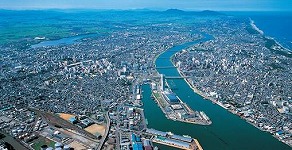 On April 1, 2007, Niigata City was reborn as the first government ordinance-designated city on the Japan Sea side of Honshu, the main island of Japan. Earlier, it completed the merger of 13 neighboring cities, towns and villages and became the largest city on the Japan Sea coast with a population of 810,000 and an outstandingly high 60% ratio of food self-sufficiency. Taking advantage of such characteristics as the geographical location and the most productive agricultural strength, Niigata intends to be a designated major city that is absolutely new.
On April 1, 2007, Niigata City was reborn as the first government ordinance-designated city on the Japan Sea side of Honshu, the main island of Japan. Earlier, it completed the merger of 13 neighboring cities, towns and villages and became the largest city on the Japan Sea coast with a population of 810,000 and an outstandingly high 60% ratio of food self-sufficiency. Taking advantage of such characteristics as the geographical location and the most productive agricultural strength, Niigata intends to be a designated major city that is absolutely new.
Here are the three pillars of its concept. A hub of Northeast Asia and beyond: reaching out from the Japan Sea coast, Niigata will not only become a center of the cultural and economical zone of Northeast Asia but also contribute globally in the fields of food, energy and environment. Second, Co-habitation of the rural and the urban: combining both agricultural and urban features, Niigata is able to offer a unique environment for farmers and business people to benefit each other. Lastly, a decentralized municipality: To develop the city, Niigata is to go with its citizens’ opinions through the activities of local communities.
If you look at the current share of Japan’s international trade value by countries, you find 50% of it goes for Asian countries and 30%, greater China. Meanwhile, US share goes down to 17.5%. The Port of Niigata is one single international port on the Japan Sea side and was listed among Japan’s top ten ports in terms of the volume of containerized freight in 2005. Thanks to the emerging economies of East Asia, it increased by an average of 16.7% a year between 1997 and 2005. As the flow of physical distribution is now gradually shifting to the ports on Japan Sea side, it is expected that the Japan Sea coast will become a stage for the world economy, in which Niigata will play a role as the axis of the Japan Sea rim.
Together with the four other old port cities that opened their ports between the late 1850s and the early 1860s, namely Yokohama, Kobe, Nagasaki, and Hakodate, Niigata opened its port in 1869 and has long developed a unique “Minato machi”, or seaport town, culture. It will host the G8 Summit Labor Ministers’ Meeting in May 2008. This is the dawn of the East Asia era. Given a chance to host the one of 2008 G8 Ministerial Meetings, what will Niigata do to use the success of this prestigious international event to become a real hub of Northeast Asia? The tour will examine Niigata’s potential as a major city on the Japan Sea coast.
*Niigata City, the host, and Foreign Press Center, Japan have co-organized this press tour.
Presentations
◆Niigata, the ordinance-designated city on the Japan Sea coast,
hosts 2008 G8 Summit Labor Ministers’ Meeting
1. Press conference by Mr. Akira Shinoda, Mayor of Niigata City
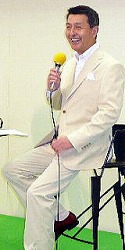
Earlier, Niigata and Yokohama jointly bid to host the G8 Summit in 2008, which they named “Old port cities Summit”, and in May this year Niigata was appointed to host the G8 Labor Ministers’ Meeting. “I wished we could have hosted the Foreign Ministers’ Meeting here in Niigata. On the shores of the Japan Sea, they could have discussed on the policies for the emerging East Asian countries as well as the plan to make the Japan Sea a symbol of peace” Niigata Mayor Akira Shinoda said frankly. However, he shows his strong commitment to make the Labor Ministers’ Meeting fruitful as he is keen to study such national issues as designing policies for more employment, NEETs, and pay raises as a result of the economic revival. He also proposes to give the Meeting a special something particular from Niigata, by stressing, for example, the roles played by the local construction firms in terms of the recovery from the Chuetsu Earthquake. The G8 Labor Ministers’ Meeting will be the first major international event since Niigata became a government designated city with a population of 810,000. How will Mayor Shinoda take the lead to make the Meeting a success? We will hear his views on the tour.
2. Briefing by Director, Niigata City 2008 Summit Promotion Division
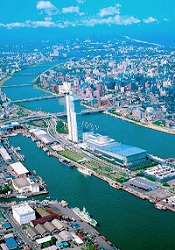 The G8 Labor Ministers’ Meeting is scheduled to take place from May 11 to 13, 2008 at Toki Messe, Niigata International Convention Center, as its main venue. This meeting is the curtain raiser of a series of the ministerial meetings that will be held in provincial cities and is expected to play a role to boost the G8 Summit. Through the Summit, Niigata City intends to publicize its strengths, such as the industry, tourism resourses, and food culture to the world. In Japan after WWII people called the Japan Sea side “ura-Nihon”, or the back of Japan, and the Pacific side, “omote-Nihon”, or the front of Japan. But this is the dawn of the East Asia era and the shoe is on the other foot. Taking advantage of long and good relationships with the emerging economies in the region, China and Russia, Niigata will be able to extend its functions as a cultural and economic hub of Northeast Asia. Director Kenzo Takahashi, Summit Promotion Division, Niigata City, will be speaking about the significance of holding the G8 Labor Ministers’ Meeting in Niigata and the potential for the Japan Sea coast to become a stage for the world economy.
The G8 Labor Ministers’ Meeting is scheduled to take place from May 11 to 13, 2008 at Toki Messe, Niigata International Convention Center, as its main venue. This meeting is the curtain raiser of a series of the ministerial meetings that will be held in provincial cities and is expected to play a role to boost the G8 Summit. Through the Summit, Niigata City intends to publicize its strengths, such as the industry, tourism resourses, and food culture to the world. In Japan after WWII people called the Japan Sea side “ura-Nihon”, or the back of Japan, and the Pacific side, “omote-Nihon”, or the front of Japan. But this is the dawn of the East Asia era and the shoe is on the other foot. Taking advantage of long and good relationships with the emerging economies in the region, China and Russia, Niigata will be able to extend its functions as a cultural and economic hub of Northeast Asia. Director Kenzo Takahashi, Summit Promotion Division, Niigata City, will be speaking about the significance of holding the G8 Labor Ministers’ Meeting in Niigata and the potential for the Japan Sea coast to become a stage for the world economy.
3. Toki Messe, Niigata International Convention Center
This convention complex is located on the waterfront, near the mouth of the Shinano River, where it flows into the Japan Sea. In the shape of a ship, this building is a landmark of Niigata City, where the 2008 G8 Labor Ministers’ Meeting will be held. In the beginning of the program, the tour will visit the observation deck on the 31st floor of Toki Messe at 125 meters from the ground and enjoy the spectacular, 360 degree panoramic view including Niigata city center, the Japan Sea, and Sado Island. The participants will see the Echigo Plain with many rice fields and the Shinano River and Agano River flowing into the Japan Sea, then realize that blessed with the farmland and sea, Niigata offers a unique environment, both rural and urban.
◆Niigata, a cultural and economic hub of Northeast Asia and beyond,
reaching out from the Japan Sea coast
4. Port of Niigata (East District) – the International Trade Port located on the Japan Sea Coast with the Largest Volume of Freight Handled
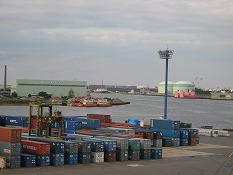 As one of the five old ports of Japan (Hakodate, Yokohama, Kobe, Nagasaki, Niigata) that opened between the late 1850s and 1860s, the Port of Niigata opened in 1869 and commemorates its 140-year anniversary in 2009. In fact, it is one single international port on the Japan Sea side and in 2005 handled approx. 31.7 million tons of incoming and outgoing ocean freight. Having reached approx. 157, 484 TEU, it was also listed among Japan’s top ten ports in terms of the volume of containerized freight in 2005. Thanks to the emerging economies of East Asia, it increased by an average of 16.7% a year between 1997 and 2005. The well-serviced ocean shipping routes include China, South Korea, and Southeast Asia, in total eleven shipping routes are in use at present. In particular, there are seven voyages a week between Niigata and Pusan, a hub port in East Asia, and this “Pusan transship” has a potential to change the flow of Japan’s physical distribution. The Port of Niigata East District functions not only as an international container terminal but also as an energy, crude oil and LNG supply base. One recent problem is that many container ships are forced to anchor offshore as the volume of containerized freight continues to grow. It is necessary to develop additional facilities as soon as possible to cope with this growth. The tour will cover the Port of Niigata East District from the sea and feel the wave of future on the Japan Sea.
As one of the five old ports of Japan (Hakodate, Yokohama, Kobe, Nagasaki, Niigata) that opened between the late 1850s and 1860s, the Port of Niigata opened in 1869 and commemorates its 140-year anniversary in 2009. In fact, it is one single international port on the Japan Sea side and in 2005 handled approx. 31.7 million tons of incoming and outgoing ocean freight. Having reached approx. 157, 484 TEU, it was also listed among Japan’s top ten ports in terms of the volume of containerized freight in 2005. Thanks to the emerging economies of East Asia, it increased by an average of 16.7% a year between 1997 and 2005. The well-serviced ocean shipping routes include China, South Korea, and Southeast Asia, in total eleven shipping routes are in use at present. In particular, there are seven voyages a week between Niigata and Pusan, a hub port in East Asia, and this “Pusan transship” has a potential to change the flow of Japan’s physical distribution. The Port of Niigata East District functions not only as an international container terminal but also as an energy, crude oil and LNG supply base. One recent problem is that many container ships are forced to anchor offshore as the volume of containerized freight continues to grow. It is necessary to develop additional facilities as soon as possible to cope with this growth. The tour will cover the Port of Niigata East District from the sea and feel the wave of future on the Japan Sea.
5. Niigata Central Wholesale Market – Supplying Authentic Niigata Food from Ecologically and Economically-Friendly "Eco-Market"
 This reborn Central Wholesale Market, launched May 2007, is a collective market of vegetables, fish, and flowers with an area of approx. 270,000 square meters, the second largest in Japan in terms of site area. In the fishery wing, there is a low temperature area, which is part of the “cold chain” to keep fish fresh, from the landing the catch through to the consumers’ table. The market is equipped with two recycling facilities: a great number of white styrolfoam called “gyobako”, or fish boxes, used and disposed of in the market every day are collected, melted and recycled; about 1 ton a day of vegetable waste from the vegetable market is collected and biodegraded to nothing. Meanwhile, regular sanitary inspectors in the employ of the municipal public health department carry out thorough hygiene control to ensure food safety. The tour will visit the supply base of Niigata’s authentic food, covering the cutting edge technology of recycling the waste and the high level operation of keeping maximum freshness.
This reborn Central Wholesale Market, launched May 2007, is a collective market of vegetables, fish, and flowers with an area of approx. 270,000 square meters, the second largest in Japan in terms of site area. In the fishery wing, there is a low temperature area, which is part of the “cold chain” to keep fish fresh, from the landing the catch through to the consumers’ table. The market is equipped with two recycling facilities: a great number of white styrolfoam called “gyobako”, or fish boxes, used and disposed of in the market every day are collected, melted and recycled; about 1 ton a day of vegetable waste from the vegetable market is collected and biodegraded to nothing. Meanwhile, regular sanitary inspectors in the employ of the municipal public health department carry out thorough hygiene control to ensure food safety. The tour will visit the supply base of Niigata’s authentic food, covering the cutting edge technology of recycling the waste and the high level operation of keeping maximum freshness.
◆Minato Machi, or Seaport Town, Niigata features Old Chic and New Esprit
6. Imayo-tsukasa Shuzo Sake Brewery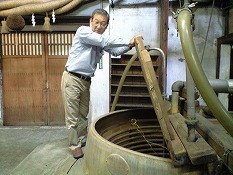 – Jun-mai-shu, or Pure rice wine,
– Jun-mai-shu, or Pure rice wine,
a Divine Gift from the Nature in Niigata
Founded in 1897, Imayo-tsukasa, meaing “governor of this age”, Shuzo is proud of its 110-year-long history of sake brewing using the local rice and water. It stubbornly produces sake from genuine rice with no alcohol added in the whole process of production. The best rice suited to sake making is “Yamada-nishiki”, the well-known brand from Kansai region. However, Mr. Yoshitaro Yamamoto, the fourth generation kuramoto, or sake master, prefers the brewer’s rice produced in Niigata and is currently anticipating the emergence of “Koshi-tanrei”, which could be better than “Yamada-nishiki”. Recently the local sake breweries and rice farmers are collaborating to develop a new brand of the best rice suited to sake making, and the “Koshi-tanrei” is not one of these. At the same time Mr. Yamamoto is worried about contamination of the local spring water and the decrease of snowfall in winter caused by global warming. The tour will have a chance to visit an old sake brewery that was built in the time when much of sake produced in Niigata was sent to Hokkaido by trading vessels called Kitamae-sen in the pioneer days of the Edo period, and see the gift from the nature in Niigata that is harmonized by Mr. Yamamoto’s deep knowledge.
7. Ryotei, or Japanese Restaurant, Nagedyaya and Furumachi Chic
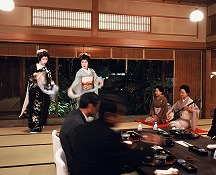 Founded in 1846, at the end of the Edo period, the Nabedyaya, a time-honored old establishment in Niigata, has carried on the traditional cuisine and art, together with its elegance, started by its founder 160 years ago. With the Furumachi geisha, it gathered many admirers from the fields of literature and art. The three-story wooden building was listed for preservation as cultural asset by the Cultural Agency in 2000 and reflects the prosperous atmosphere from old “Minato machi, or seaport, culture. Furumachi is a noted geisha quarter in Niigata. In the past Furumachi was the one of the most prestigious geisha quarters, including Gion, Akasaka, and Shimbashi. There were about 400 Furumachi geisha at the peak time, but there are only 30 these days. However, they have a variety of generations and the all, from young to old, belonging to the Japanese traditional dance school “Ichiyama-ryu”. The Ichiyama-ryu school, listed at the top of the intangible cultural assets by Niigata City, is an unusual school in that it was established in a provincial city and developed by itself in the same place for 120 years or more. With its highly appreciated artistic quality, it has contributed to the development of the Furumachi geisha quarter as well as the traditional dance world in Japanese culture. On the second day of the tour, the participants will have lunch at Nabedyaya and enjoy the Furumachi geigi (geisha) dance with the 120-year-long history of the Ichiyama-ryu school.
Founded in 1846, at the end of the Edo period, the Nabedyaya, a time-honored old establishment in Niigata, has carried on the traditional cuisine and art, together with its elegance, started by its founder 160 years ago. With the Furumachi geisha, it gathered many admirers from the fields of literature and art. The three-story wooden building was listed for preservation as cultural asset by the Cultural Agency in 2000 and reflects the prosperous atmosphere from old “Minato machi, or seaport, culture. Furumachi is a noted geisha quarter in Niigata. In the past Furumachi was the one of the most prestigious geisha quarters, including Gion, Akasaka, and Shimbashi. There were about 400 Furumachi geisha at the peak time, but there are only 30 these days. However, they have a variety of generations and the all, from young to old, belonging to the Japanese traditional dance school “Ichiyama-ryu”. The Ichiyama-ryu school, listed at the top of the intangible cultural assets by Niigata City, is an unusual school in that it was established in a provincial city and developed by itself in the same place for 120 years or more. With its highly appreciated artistic quality, it has contributed to the development of the Furumachi geisha quarter as well as the traditional dance world in Japanese culture. On the second day of the tour, the participants will have lunch at Nabedyaya and enjoy the Furumachi geigi (geisha) dance with the 120-year-long history of the Ichiyama-ryu school.
8. Ryutopia, Niigata City Performaing Arts Center, and Contemporary Dance Company "Noism"
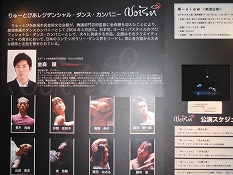 Ryutopia, Niigata City Performing Arts Center, is the base for spreading culture and art from Niigata, housing such facilities as a concert hall, theater, Noh theater, studio, and gallery. It also has its own contemporary dance company named “Noism”, that is the Japan’s first resident dance company based on a local government facility. “Noism” was established in April 2004 when Ryutopia invited Mr. Jo Kanamori to be the Artistic Director of the Dance Division. With their highly creative pieces, this European style dance company is now taking the lead in contemporary dance in Japan and attracts high interests and attention from all quarters. This year it conducted a tour of five cities in North and South America, and also gave a performance in Russia. The participants will visit the dance company “Noism” at its rehearsal studio in Ryutopia and talk with Director Jo Kanamori.
Ryutopia, Niigata City Performing Arts Center, is the base for spreading culture and art from Niigata, housing such facilities as a concert hall, theater, Noh theater, studio, and gallery. It also has its own contemporary dance company named “Noism”, that is the Japan’s first resident dance company based on a local government facility. “Noism” was established in April 2004 when Ryutopia invited Mr. Jo Kanamori to be the Artistic Director of the Dance Division. With their highly creative pieces, this European style dance company is now taking the lead in contemporary dance in Japan and attracts high interests and attention from all quarters. This year it conducted a tour of five cities in North and South America, and also gave a performance in Russia. The participants will visit the dance company “Noism” at its rehearsal studio in Ryutopia and talk with Director Jo Kanamori.
Tour itinerary and application details
1. Itinerary (Tentative): November 12-13, 2007
<DAY 1: Monday, November 12>
08:10 Meet at JR Tokyo Station (Joetsu Shinkansen platform)
08:24 Leave by Joetsu Shinkansen Max Toki 309
10:38 Arrive at Niigata Station (Move by Niigata City’s chartered bus)
11:00-11:40 Visit TOKI MESSE Observation Deck and the Summit Venue
11:40-12:40 Lunch (@Restaurant Aoisara in TOKI MESSE)
13:20-15:10 Visit Port of Niigata, Container Terminal in East District
15:50-16:50 Visit Imayo-tsukasa Shuzo Sake Brewery
17:10 Check-in at Hotel Nikko Niigata, followed by a break
18:30-20:00 River cruise by Shinanogawa Water Shuttle and dinner hosted by Niigata City on the boat
(Stay overnight at Hotel Nikko Niigata)
<DAY 2: Tuesday, November 13>
08:00 Leave hotel (Move by Niigata City’s chartered bus)
08:30-10:00 Visit Niigata Central Wholesale Market
10:40-11:40 Press Conference by Mayor Akira Shinoda
11:40-12:40 Briefing by Director, Summit Promotion Division, Niigata City
13:00-14:40 Visit Japanese restaurant Nabedyaya(Cover Furumachi geisha's dance and interview them, followed by lunch)
14:55-16:10 Visit Ryutopia, Niigata-City Performing Arts Center and "Noism" Dance Company
16:30 Arrive at Niigata Station
17:11 Leave by Joetsu Shinkansen Max Toki 340
19:20 Arrive at Tokyo Station
2. Qualification: Bearer of Gaimusho Press Registration card
3. Expenses: 13,000 yen per person including transportation, meals and accommodation
*FPCJ will inform the participants of payment methods, cancellation fee etc. later on.
4. Participants: Limited to the first 10 applicants on a first-come first-served basis.
(Only one reporter and one photographer from each company, but two participants from each TV team will be acceptable.)
5. FPCJ Contact: Ms. Koizumi and Ms. Yoshida (Tel: 03-3501-5070)
6. Remarks:
(1) There are some restrictions on photographing and filming at the tour sites. Please follow the instructions of the officials on duty.
(2) Niigata City and FPCJ will not be liable for any inconvenience, trouble or accident that might occur in the course of the tour.



